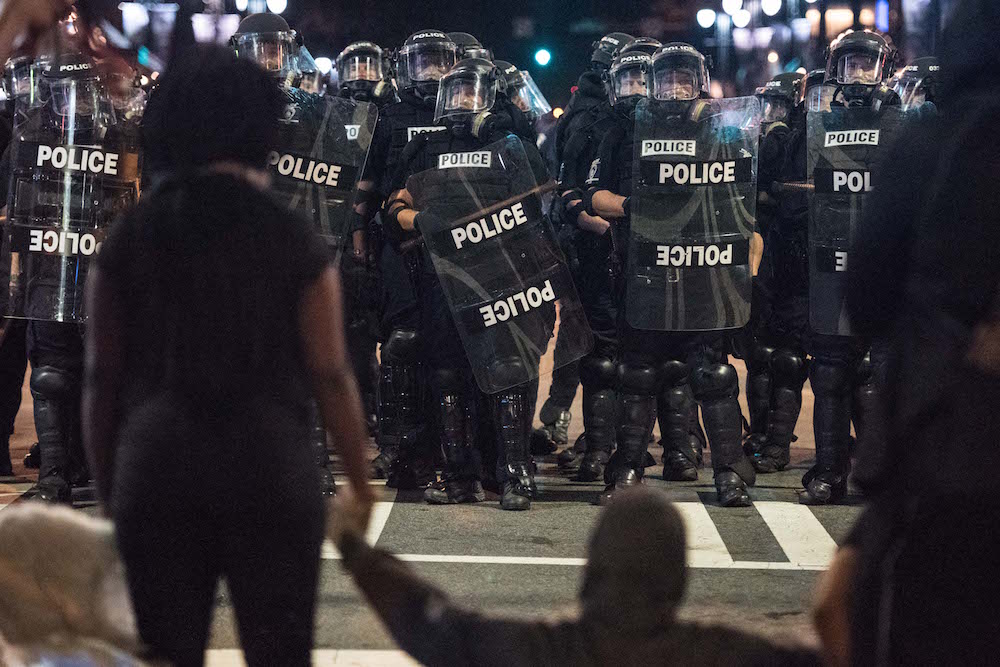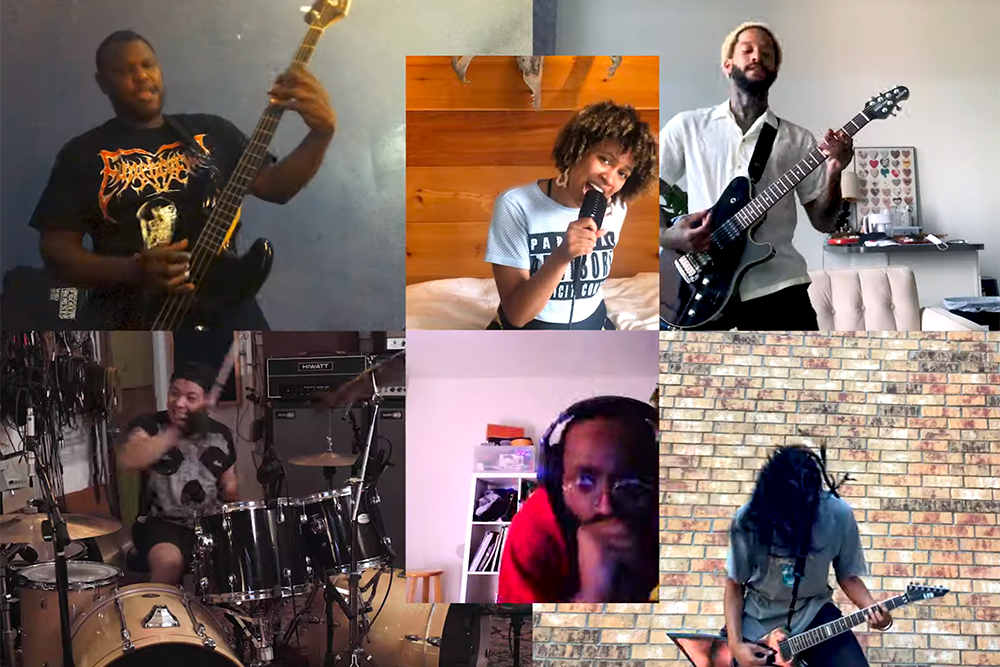In November 2014, after a grand jury elected not to indict Ferguson, Mo., police officer Darren Wilson for the killing of Michael Brown, Brown’s family released a public statement lamenting the decision and pleading for peaceful protests. They also had another request, which they hoped might prevent more men like their son from being killed in the future. “We need to work together to fix the system that allowed this to happen,” the statement read. “Join with us in our campaign to ensure that every police officer working the streets in this country wears a body camera.” Nearly two years later, that campaign is well on its way to what most would consider a success, but the killing of black men by the police seems to continue unabated. Last week, an officer in Tulsa shot and killed Terence Crutcher, an unarmed black man who was holding his hands above his head, and cops in Charlotte shot and killed Keith Scott a few days later.
The most recent numbers available from the federal Bureau of Justice Statistics, which predate Michael Brown’s killing by a year, showed that about a third of all U.S. police departments were using body cameras in some capacity in 2013. It’s unclear how many departments have begun using the technology since then, but there have been some prominent adopters. In the wake of Brown’s killing, President Barack Obama announced $75 million in federal funding to help departments buy body cameras, and the Los Angeles Police Department announced a body camera pilot program less than a month later.
This past June, the LAPD also became the first of the nation’s largest departments to adopt cameras on a large scale, when it expanded its initial program to include 7,000 new cameras at a cost of about $57.6 million. A recent survey of law enforcement agencies by the Major Cities Chiefs Association and Major County Sheriffs’ Association found that 95 percent of responding departments intend to implement cameras at some point, and that half had already gotten at least as far as a pilot program. We’re still a long way from universal use of cameras, and some early adopters have since dropped their programs because they can’t afford to maintain them. But in the time since Ferguson, initial enthusiasm for the technology in the law enforcement community has hardened into something like accepted wisdom.
Body Cameras as Accountability
A big reason for the wildfire success of body cameras is that both police departments and anti-police brutality activists see them as a boon to their causes. For cops, footage has the power to exonerate an officer whose use of force might have been justified: if a suspect is caught on camera waving a gun around, it’s a lot easier to explain why you used your own gun against him. For activists, body cameras provide hard evidence of police violence and an opportunity to cut through the so-called “blue wall of silence”: if a cop beats or kills a person for no reason, his buddies might be tempted to invent a story of a deadly threat in order to justify it, and cameras only show what actually happened.
There’s also the idea that the mere presence of a body camera, with its promise of accountability for both sides, might be enough to diffuse potentially violent situations on its own. The most prominent study of the effects of cameras on encounters between cops and civilians, conducted in Rialto, Calif., found that use of force by officers there dropped by 59 percent and complaints against officers dropped by 87 percent after body cameras were put into use.
If body cameras are so good at de-escalation and accountability, how do you account for the deaths of Crutcher and Scott–both of which were captured on video? Taken together, these two cases illustrate both the potential benefits of body cameras and the pitfalls of relying on them as a magic solution.
Keith Scott’s death presents what would at first seem like a textbook case for the effectiveness of video evidence–it’s the kind of contradictory testimony that led Michael Brown’s family to call for the use of body cameras in the first place. According to police, Scott was carrying a gun, and presented a threat to officers; according to one eyewitness, what the cops took for a gun was actually a book. On a cell phone video shot by Scott’s wife, she can be heard shouting “He doesn’t have a gun!”, but the video does not show the shooting itself or definitively settle the question of whether he was armed.
In the case of Michael Brown, there was no video evidence to be had–there were witnesses that claimed he made an aggressive charge at Wilson, and others who claimed he held his hands up to surrender. Scott’s death, however, had plenty of video footage. Three officers were wearing body cameras at the scene of Scott’s killing, and a dash cam on a nearby police cruiser was also running. But it’s unlikely that footage will ever be seen by anyone more than a handful of government officials and Scott’s family members.
The Police’s Relationship with Public Records
Understanding why might require a quick briefing on public records law. In the U.S., and in all 50 states, we have laws mandating the disclosure of certain government documents to citizens, including emails, departmental memoranda, photographs, and yes, video footage. American citizens elected them; they pay the taxes that fund their salaries; they are entitled to know exactly how their votes and their dollars are being put to use. Police departments are broadly covered under state public records laws, but there are all sorts of exemptions that allow them to withhold documents from release. Many of these are legitimate: you can understand why a department wouldn’t want to give out case files that would let a serial killer know that the cops are on his tail, for instance. But even if a requester is looking for something that’s clearly in the public interest, law enforcement agencies can sometimes make it extremely difficult to get. (I don’t how many records requests I’ve sent to the NYPD over the last few years, but I can tell you for sure that exactly none of them have been successful.)
Though body cameras are still a new technology, their footage would seem to straightforwardly qualify as a public record in most cases. However, in July, the North Carolina legislature and Governor Pat McCrory took the unique step of prohibiting the public from viewing any police body and dashboard camera footage without a court order, meaning the Charlotte cops are under no obligation to make the footage from Scott’s death public. “Technology like dashboard cameras and body cameras can be very helpful, but when used by itself technology can also mislead and misinform, which causes other issues and problems within our community,” McCrory argued at the time.
Several legal experts, including North Carolina’s own attorney general, took issue with McCrory’s decision. “It’s just not clear to me why this category of video footage is so different than everything else that is created by public employees, that it needs to be treated in this really unique way that makes it really hard for the public to get access to it,” a local law professor told Pacific Standard when asked about the law. Police officers’ written reports are accepted as records in North Carolina, as is the footage from government-owned surveillance cameras that aren’t affixed to police officers’ lapels. Why should body camera footage be any different?
More than creating a loophole in public records law, McCrory’s decision violates the mutual trust between police and citizen that body cameras are supposed to engender. How can an ordinary person know the cops are telling the truth about what’s on the tape of Scott’s death without seeing it for themselves? If you’re not going to release the footage, why record it in the first place?
The idea that cops would withhold footage to protect their officers isn’t some harebrained conspiracy theory. When a Chicago police officer named Jason Van Dyke shot and killed Laquan McDonald in 2014, police initially claimed that McDonald had lunged at the officer with a knife. The police denied dozens of public records requests for dash cam footage from the killing, and officers seem to have tampered with a surveillance camera at a nearby Burger King so that its footage was also inaccessible. (In a CPD shooting from this year, officers who were equipped with body cameras simply didn’t turn them on in the first place.) Video of McDonald’s death only became public after a freelance reporter sued the police department, and it what it showed was starkly different from the official line. McDonald was facing away from officers, not lunging at them, and Van Dyke shot him 16 times. Some of those shots were fired after McDonald had fallen to the ground. In December 2015, Van Dyke was indicted for murdering McDonald, over a year after killing him.
If Scott’s death presents a case for the futility of body cameras when police refuse to release footage, Terrence Crutcher’s shows how illuminating the technology can be when it is used in a transparent manner. On the evening of September 16, Tulsa police officer Betty Shelby fired shot and killed Crutcher after responding to a report of an abandoned vehicle. Crutcher was unarmed, he did not have a weapon in his vehicle, and he was raising his hands above his head and walking slowly when Shelby killed him.The facts of Crutcher’s death are so much clearer than those of Scott’s specifically because Tulsa police promptly released their footage of the shooting. (The Crutcher footage comes from a helicopter and a dash cam, not a body camera.)
It was immediately clear to the public, and to prosecutors, that Crutcher did not need to die, and Shelby was arrested and charged with manslaughter on Thursday.In this case, camera footage led to an officer being charged with a crime, but there are cases in which officers were exonerated based on video evidence as well. Whether the evidence supports the cops’ actions or calls them into question, body cameras work best when their footage is made public.
Not A Cure-All
Even the prompt release of video footage is not a guarantee that justice will be served. Sometimes it just isn’t clear enough: Keith Scott’s family, who were allowed to review the footage of his death, said that watching it left them with “more questions than answers.”
And sometimes clear footage isn’t enough to counter the weight of institutional bias in cops’ favor. After watching video of an NYPD officer killing Eric Garner, there can be little doubt about what happened. Garner was unarmed; he was overpowered by the officers on the scene; he called out multiple times that he was unable to breathe before succumbing. Still, Daniel Pantaleo, the officer who killed him, was not indicted or even removed from the force. The footage was shot on a cell phone by a bystander, but it’s hard to imagine official body camera video would have made any difference.
Prosecutors and grand juries have a well documented aversion to indicting police officers who shoot suspects, with or without body camera evidence. Of the roughly 800 fatal police shootings that took place between January and October of last year, only 15 led to murder or manslaughter charges for the officers involved–and that was considered a statistical uptick. Not to mention that, as Mario Aguilar at Gizmodo pointed out in a thorough history of body cameras last year, the technology itself has a pro-police bias built in as well. Taser, which manufactures body cameras in addition to stun guns, explicitly markets its AXON model for its ability to prove officers innocent. When an Arkansas police officer named Brandon Davis became the first cop to be exonerated for a shooting based on body camera evidence, Taser enlisted him as a pitchman. “Officer Davis was wearing the AXON when his incident occurred,” reads the copy accompanying one AXON marketing video. “The result? Officer Davis was exonerated almost immediately and returned to work within 72 hours of the event.”
Any technology that provides the public with more information about a killing by police is valuable. When departments throw money into instituting a program like body cameras, it feels like progress toward reform, but that progress is only as valuable as the transparency and honesty with which it is implemented. The problems that drive police violence–institutional and individual racism, laws that allow cops to live far away from the communities they are tasked with patrolling, a culture that discourages officers from speaking up when they witness misconduct, to name a few–are far too deep-seated to be fixed by a single piece of equipment. Body cameras should not be thought of as an easy fix to the problem of police violence. If they were, Crutcher and Scott might still be alive today.
Update (9:15 p.m., September 24): After reversing its decision on Saturday afternoon, the Charlotte police department has released dashboard and body camera footage of the shooting of Keith Lamont Scott. Here is a YouTube upload (via CNN). Note that the footage is graphic.





